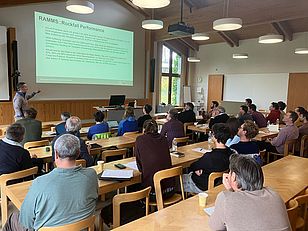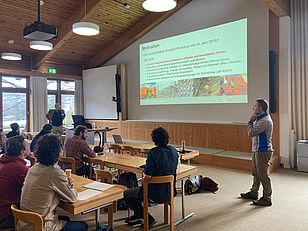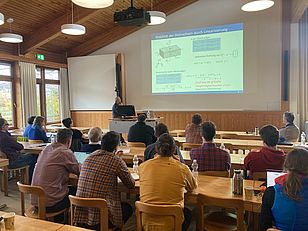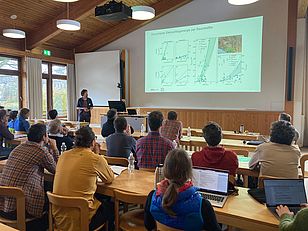RAMMS::Rockfall XChange Workshop
Datum:
Ort:
WSL Birmensdorf, Hörsaal
Organisiert von:
WSL SLF
Sprache(n):
Deutsch
Veranstaltungstyp:
Congresses and conferences
Last week, the RAMMS team invited natural hazard practitioners from Switzerland, Germany and Austria to an XChange workshop on rockfall. The aim of the workshop was to present new research findings from the last 5 years, which have led to a major update of the RAMMS::Rockfall software. The new rockfall software will be released in early 2024. The key new features presented were:
- New soil interaction model between rock and terrain: This new model allows the rock to penetrate a deformable layer before rebounding, leaving a permanent scar. This enables a more realistic energy dissipation mechanism, more intuitive input parameters without dependence on rock size and an additional plausibility check when comparing the simulated scar depths with the observed ones. The new modelling idea is the result of a large number of real-scale experiments conducted over the last 5 years, which have also been used to calibrate a wide range of default soil parameters.
- New forest interaction model on single tree level: This new model now accurately reproduces the rock shape dependency of the protective effect of forests and can stop platy rocks even on steep slopes. The model is validated with a unique set of real-scale rockfall experiments in forests. In addition, the protective effect of deadwood after a windthrow event can be quantified using a new automatic deadwood generator.
- A new custom integration scheme, which also takes into account the conservation of spin, improves the stability of platy rocks rolling around the principal axis of highest inertia - even at very high rotational speeds.
- New features for more efficient planning of protective measures: Barriers, sheds and dams are now 3D obstacles that can stop rocks depending on their energy absorption capacity. Additional statistical analysis tools have been implemented to quantify the efficiency of the proposed protection measures.
Additionally, ongoing key research projects were presented and intensively discussed:
- New probabilistic definition of initial conditions for a probability-based hazard assessment
- New FE model in the nonsmooth dynamics framework for the calculation of impact forces in rockfall barriers
- New roughness modelling for a more realistic interaction of rocks on scree and to eliminate the dependence on DEM quality in simulations.
The event concluded with various presentations by natural hazard practitioners on current projects and the associated challenges.
We would like to thank everyone for their participation. The event has shown that there is still great potential in rockfall modelling. The close contact and collaboration between research and practice is of utmost importance to overcome these challenges and to transfer research into an applicable and efficient tool.



